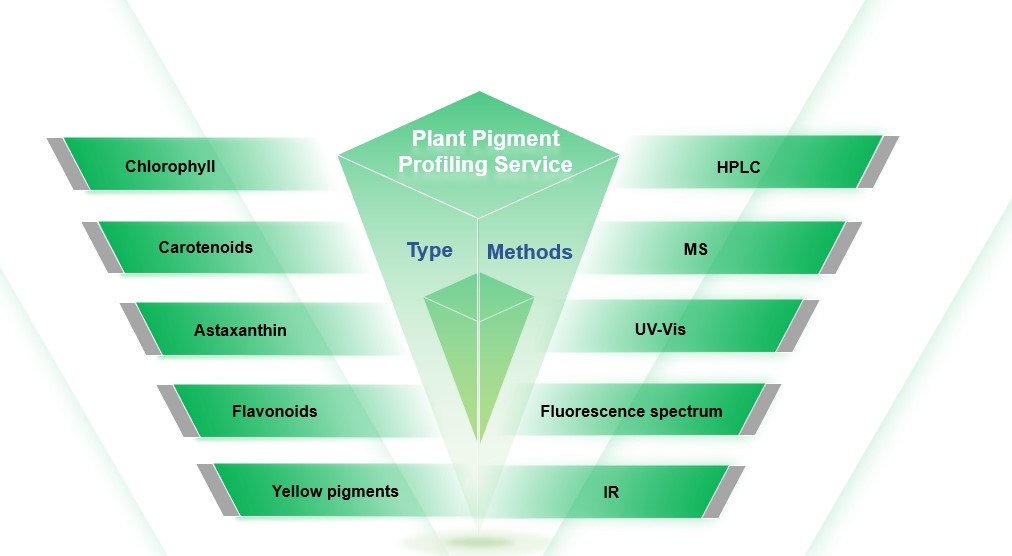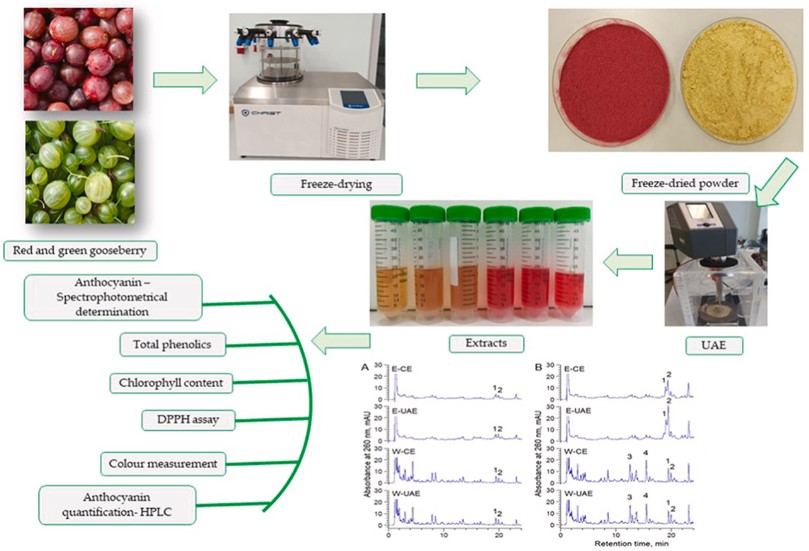Plant Pigment Profiling Service
Services Published Data FAQs Customer Review
High-quality Profiling of Plant Pigment at Creative Biolabs
Plant pigments are important nutrients in plants, and their analysis is used to monitor sources of biomass in the environment. Certain plant pigments provide antioxidant substances needed by the human body and are often used as food additives. During food processing, plant pigments can be damaged or lost, so plant pigment analysis can help the food industry ensure the quality and nutritional value of their products. Creative Biolabs has advanced analytical technology and laboratory facilities, and our professional team accurately measures and analyzes the composition and content of plant pigments.
We offer many types of plant pigment profiling services:
-
Chlorophyll: Chlorophyll is one of the most common pigments in plants, which includes chlorophyll a and b. Their molecular structures are different, but they can both absorb light. Chlorophyll a has absorption maxima at 372 nm and 642 nm, and chlorophyll b at 392 nm and 626 nm. Chlorophyll a has been used as a natural green colorant in food and formulations.
-
Carotenoids: Carotenoids are a type of plant pigments, including α-carotene, β-carotene, etc. They are widely used as health supplements, food colorants, and feed additives.
-
Astaxanthin: Anthocyanins are a type of plant pigment, which is a natural anti-inflammatory agent.
-
Flavonoids: Flavonoids are a class of secondary metabolites that are widely present in many plants and have activities such as anti-cancer, anti-inflammatory, and antioxidant.
-
Yellow pigments: Yellow pigments are a type of yellow pigment found in plants, including lutein, zeaxanthin, etc. Research shows that lutein and zeaxanthin have antioxidant and anti-inflammatory activities, which can prevent macular degeneration and slow down the progression of eye diseases.
Creative Biolabs has a variety of analytical methods, and we accurately analyze different types of plant pigments:
-
High-performance liquid chromatography (HPLC): HPLC is a common technique for separating and quantifying plant pigments. We dissolve the sample in the mobile phase and use column packing to separate the different pigments, and then detect and quantify them through the detector.
-
Mass spectrometry: We combine HPLC and mass spectrometry technology (LC-MS/MS) to more accurately identify and quantify plant pigments, which provides more detailed molecular information and helps identify unknown compounds.
-
Ultraviolet-visible absorption spectroscopy (UV-Vis): UV-Vis spectroscopy is used to measure the absorbance of plant pigments, thereby determining their presence and concentration. This allows for rapid screening and quantitative analysis.
-
Fluorescence spectrum analysis: It is used for qualitative and quantitative analysis of certain specific plant pigments. Plant pigments often emit fluorescent signals at specific wavelengths, and this method is highly sensitive to certain pigments.
-
Infrared spectroscopy (IR): IR is used to study the functional groups and structure of plant pigment molecules. This technique helps confirm the molecular structure of certain plant pigments.

In addition to plant pigment analysis, as a professional analytical service company, Creative Biolabs also provides clients with high-quality and reliable other Plant Chemistry Profiling services in biomass, including Plant Cell Wall Analysis, Plant Elements, and Vitamin Profiling services. If you would like to obtain more analysis details, please contact us in time and we will respond to your needs quickly.
Published data
Haematococcus pluvialis is microalgae rich in a variety of active compounds and can serve as one of the main sources of carotene, carotenoids, and astaxanthin. The carotenoid composition and content of H. pluvialis microalgae will change a lot at different stages of its life cycle. In this study, the authors used high-performance liquid chromatography with diode array detector (HPLC-DAD) and liquid chromatography quadrupole time-of-flight mass spectrometry (LC-QTOF-MS) technology to identify and evaluate the content of carotenoids and other pigments in H. pluvialis microalgae at different growth stages (green nutritional stage and red stage). The results showed that the carotenoid content of H. pluvialis microalgae in the red nutritional stage was significantly higher than that in the green stage. This study provided new data on the pigment composition and content of H. pluvialis, laying a scientific foundation for improving the aquaculture quality of this algae.
 Fig.1 LC-QTOF-MS chromatogram of H. pluvialis microalgae.1
Fig.1 LC-QTOF-MS chromatogram of H. pluvialis microalgae.1
FAQ
Q1: What are your requirements for plant samples? Does it require special handling?
A1: We usually need to receive fresh or dried plant samples. If special handling is required, we provide detailed guidance, such as volatile solvent extraction or other pre-treatment steps.
Q2: What is the detection limit of your analytical method? How accurate is it?
A2: Our methods typically have very low detection limits, usually at ppm or lower. We ensure the accuracy of the analysis by using internal standards and calibration curves.
Q3: How do you process and analyze the resulting data? What contents will be included in the report?
A3: We use professional data processing software for data analysis and generate comprehensive analysis reports. Reports typically include the content of various plant pigments in the sample, their relative proportions, and possible assessment of biological activity.
Customer Review
Reliable Quality and Expert Level
"I was very impressed with the quality control of the Creative Biolabs team and the reliability of the analytical results was reassuring. Their team demonstrated a high degree of professionalism and not only maintained high standards during sample handling and analysis but also exceeded my expectations."
Accurate Data and Detailed Reports
"I was very satisfied with the analysis results provided by Creative Biolabs. The data was accurate and the analysis report was detailed. It not only included the content of various plant pigments but also provided relative proportions and related explanations, giving me a clear understanding of the pigment composition of the sample."
Reference
-
Grujić, Veno Jaša, et al. "Diversity and Content of Carotenoids and Other Pigments in the Transition from the Green to the Red Stage of Haematococcus pluvialis Microalgae Identified by HPLC-DAD and LC-QTOF-MS." Plants 11.8 (2022): 1026. Distributed under Open Access license CC BY 4.0, without modification.
For Research Use Only.
Related Services


 Fig.1 LC-QTOF-MS chromatogram of H. pluvialis microalgae.1
Fig.1 LC-QTOF-MS chromatogram of H. pluvialis microalgae.1

